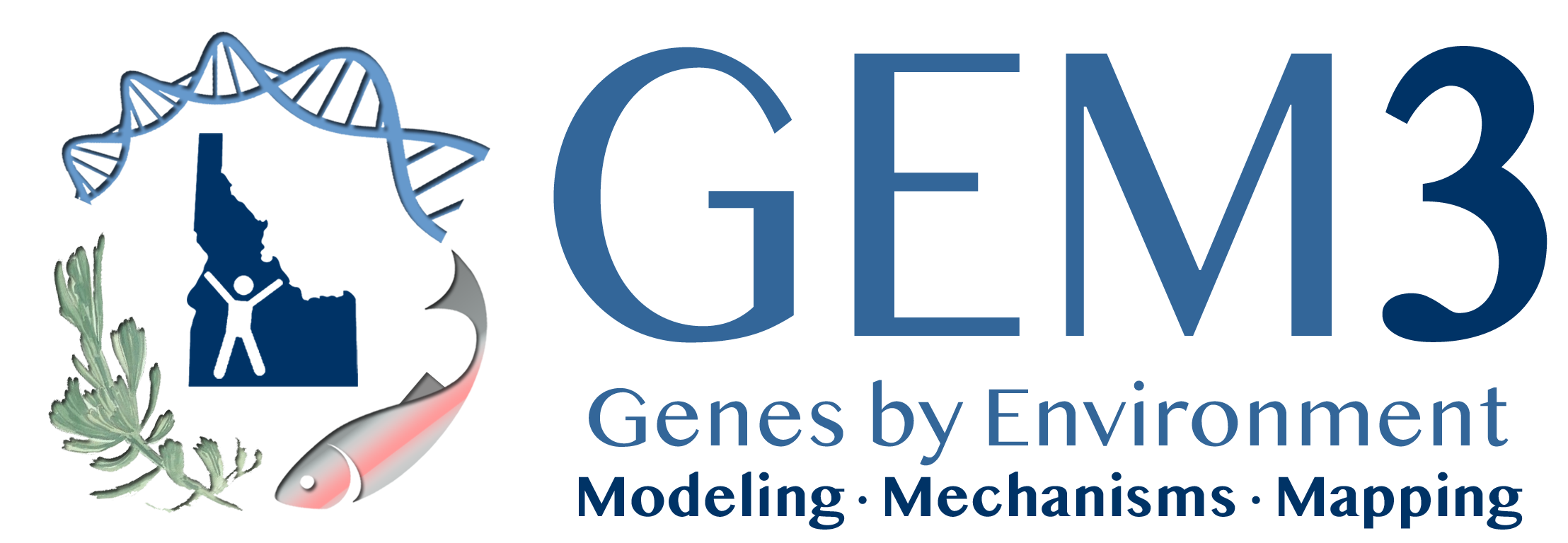GEM3 is an NSF EPSCoR research program seeking to understand how genetic diversity and phenotypic plasticity affect species response to environmental change, shaping both population response and adaptive capacity. Two focal taxa will be under study: one aquatic (redband trout) and one terrestrial (sagebrush). These taxa are integral to ecosystems in the American West, and are central to land-use management decisions that drive the economy of the region.

Redband Trout

Sagebrush
GEM3 is funded by EPSCoR, a program designed to fulfill the mandate of the NSF to promote scientific progress nationwide. EPSCoR's RII Track-1 awards provide up to $20 million over 5 years to support improvements to physical and cyber infrastructure and to develop human capital in research areas selected by Idaho's EPSCoR steering committee as having the best potential to improve future R&D competitiveness of the State.
RII Track-1 Award (2018-2023)
Linking Genome to Phenome to Predict Adaptive Responses of Organisms to Changing Landscapes
This award will advance fundamental knowledge on the mechanisms that rule genome to phenome pathways to predict how species adapt to external stressors and a changing environment. It will help translate this knowledge into evidenced-based resource management policies and practices for more adaptive and resilient species and landscapes.
Idaho's approach is through Genes to Environment: Modeling, Mechanisms, and Mapping (GEM3). This statewide project combines research strengths in bioinformatics, complex modeling, ecology, fisheries science, genomics, geospatial science, remote sensing, and social-ecological systems (SES) science to contribute to one of the most compelling and contemporary national challenges of our time – understanding the "Rules of Life: predicting phenotypes from what we know about the genome and environment".

At the same time, an additional goal is to strengthen and diversify Idaho's STEM workforce. GEM3 includes a statewide participatory research program committed to the concept of Idaho EPSCoR's "ONEIdaho" vision of an integrated, productive and creative research culture and community of Idaho researchers that transcends institutional boundaries. GEM3 researchers will work across institutions on pilot studies and case studies, fostering integration of science and stakeholders, integration of science disciplines, and integration of research and education.

A fully integrated research, education, diversity, and workforce development program will be implemented to increase the number, diversity and preparation of skilled scientists and engineers in GEM3 fields (bioinformatics, computational biology, conservation genetics, ecosystem management). GEM3 adopts a Vertically Integrated Projects (VIP) strategy to establish an on-ramp for students and provide a range of training, mentoring and professional development support to both students and faculty; it will be implemented statewide. The goal is to provide the scaffolding to support transdisciplinary science and grow the next generation of conservation science leaders and workers.

GEM3 will leverage state and federal resources to promote sustainable outcomes. Overall, 61% of Idaho land is owned and managed by federal agencies. Engagement of agency partners at all levels (biologists, land managers, policy makers, and administrators) will facilitate integration of science into management and policy and provide opportunities for knowledge sharing and development of professional networks between students and potential future employers.
The State of Idaho has demonstrated long-standing commitment to develop its research bases through EPSCoR by contributing to non-federal match as part of the appropriation for the State Board of Education (SBOE). GEM3 is fully aligned with, and guided by the state's S&T plan, Strategic Research Plan for Idaho Higher Education approved by the SBOE. The Idaho EPSCoR Committee selected GEM3 following an analysis by Elsevier Global Strategic Alliances and a rigorous year-long external review process. The topic was deemed to have the highest impact based upon several factors, including:
- contribution to long-term economic and educational priorities of the state;
- seamless integration of the academic strengths and priorities of the state's research universities;
- ability of Primarily Undergraduate Institutions (PUIs) to contribute to the integrated research, education and workforce development activities;
- industry demand for a larger, more diverse and better trained biological sciences workforce; and
- value add to national strategic priorities.
A core group of over 30 GEM3 researchers and educators, many with existing cross-institutional and cross-discipline collaborations worked together to develop this inspiring research and education plan.
GEM3 in a Nutshell
GEM3's research hypothesis is that genetic diversity, or more accurately adaptive genetic variation, of populations will vary across key landscape axes in predictable ways and influence the adaptive capacity of populations.
 Using a landscape approach, key objectives are to:
Using a landscape approach, key objectives are to:
- develop, validate, and test models that use genotype by environment knowledge to predict adaptive capacity of populations across space and time;
- use common garden experiments to identify the genetic, environmental, and phenotypic mechanisms in organisms that translate to adaptive capacity of populations;
- map, monitor, and manage genotype by environment outcomes in populations across complex Social Ecological Systems (SES).
